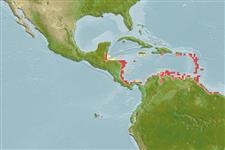Common names from other countries
Classification / Names / Names
ชื่อสามัญ | ชื่อพ้อง | Catalog of Fishes (gen., sp.) | ITIS | CoL | WoRMS
Environment: milieu / climate zone / depth range / distribution range
นิเวศวิทยา
; ระดับความลึก 0 - 2 m (Ref. 83435). Tropical; 18°N - 6°N, 88°E - 35°E (Ref. 83435)
Western Atlantic: Caribbean and Lower Antilles to northern South America.
Length at first maturity / ขนาด / น้ำหนัก / Age
Maturity: Lm ? range ? - ? cm Max length : 4.0 cm NG เพศผู้/กระเทย; (Ref. 83435); common length : 2.5 cm TL เพศผู้/กระเทย; (Ref. 344)
Shell wedge-shaped, inflated. Posterior slope flat or concave, with fine radial threads. Colour: variable, usually cream with purplish or bluish tinges. Umbones usually darker hues.
Habitat: Infaunal in shallow sand, usually in environments rich in particulate organic matter (Ref. 344).
Life cycle and mating behavior
วัยเจริญพันธุ์ | การสืบพันธุ์ | การวางไข่ | เซลสืบพันธ์ของเพศเมีย(ไข่) | ความดกของไข่ | ตัวอ่อน
Members of the class Bivalvia are mostly gonochoric, some are protandric hermaphrodites. Life cycle: Embryos develop into free-swimming trocophore larvae, succeeded by the bivalve veliger, resembling a miniature clam.
Leal, J.H. 2003. (Ref. 344)
IUCN Red List Status (Ref. 130435)
CITES status (Ref. 108899)
Not Evaluated
Not Evaluated
Threat to humans
Harmless
Human uses
การประมง: การค้า
| FishSource |
เครื่องมือ
แหล่งที่มาจากอินเตอร์เน็ต
Estimates based on models
Preferred temperature
(Ref.
115969): 27 - 28.4, mean 27.6 (based on 174 cells).
ความสามารถในการกลับคืนสู่ปกติ
ความสูง, เวลาต่ำสุดที่จะทำให้ประชากรเพิ่มขึ้นเป็น 2 เท่าใช้เวลาน้อยกว่า 15 เดือน (K=0.8).
